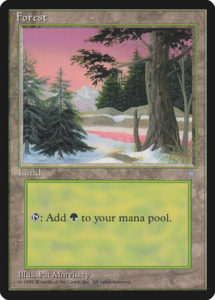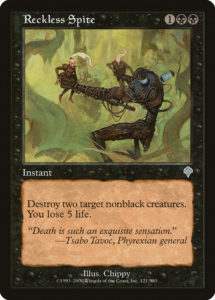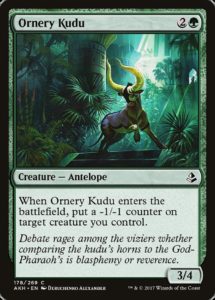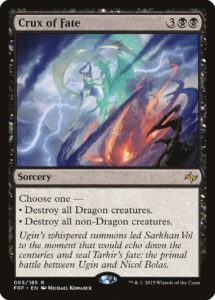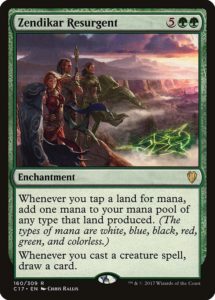Welcome to the conclusion of this three part series exploring the ways Magic tells its stories. In Part 1, we covered the traditional narrative, the kinds of stories you read about in books and that don’t always translate well to Magic cards (unless you’ve also read a companion novel). In Part 2, we explored just a tiny slice of card narratives, where a single card communicates its own story—these encompass stories as simple as Disintegrate, Magic-referential stories as with The Mending of Dominaria, and resonant stories such as Delver of Secrets and Hundred-Handed One.
We conclude our series with the set narrative, a relatively recent innovation. A set narrative uses the affordances of card narratives to communicate traditional-style narratives in a way unique to Magic. In other words, it combines what we discussed previously in this series to do something new.
Location, Location, Location
Ice Age was perhaps the first great innovation in Magic’s ability to tell its own larger narratives via cards. To understand the world of Antiquities, you needed to read a book, or at least a ton of flavor text. The Dark did a good job of communicating a mood, but little to communicate the place. Then, in 1995, there was Ice Age. For the first time, a set’s name and much of its artwork told players about the world and its environment. Basic lands were covered in snow. Fyndhorn Elves lived in snow woodlands, unlike Llanowar Elves. There were even snow-covered basic lands and cards which cared about snow lands.
This might seem like a small innovation, but this was the first time Magic provided a strong sense of place. Sure, there were outliers like Flame Spirit that undermined the messaging, but you could open a booster pack of Ice Age and be very likely to see cards that said, “Yes, this set features an ice age.” And unlike Arabian Nights, this was the first time you had a strong sense of place that was Magic’s own intellectual property rather than a rehash of source material. Ice Age demonstrated that communicating a world requires consistent messaging—having the right set name mixed with a high as-fan (Wizards lingo for “enough cards of a certain kind showing up in the majority of booster packs”) is the magic recipe.
Magic would get drastically better at communicating environments with 2003’s Mirrodin. This was the start of the era where Magic embraced its multiverse of planes rather than stay on Dominaria (with some forays onto Rath, Mercadia, and Ulgrotha). Starting with Mirrodin, each world had a specific mechanical and visual identity. This might have made them seem smaller than massive worlds like Dominaria, but it also made them coherent and comprehensible. If people had metal embedded in their bodies, you were probably looking at Mirrodin. Hedrons floating in the air? Zendikar. Bright colors and a playful mood? Lorwyn. Fancy hats and zombies? Innistrad. All of Magic’s strength at demonstrating a coherent location with its own traits and visual style can be traced back to Ice Age’s successes, making the most important and effective kinds of stories Magic tells via cards.
The Faction Factor
Magic has long had conflict as a central factor to a set’s narrative, but it wasn’t until 2000’s Invasion block that you could see a war play out across an entire set. The conflict wasn’t quite splayed out over a majority of the cards (that innovation wouldn’t happen for a long time); but it was the first block to introduce a war, and with war comes factions. For the first time, there were clear sides to choose from (the rainbow coalition vs. the monoblack Phyrexians). We’d seen small attempts at factions in Mirage and Tempest’s various groups, but this was the first time there was a clear, all-encompassing conflict between coherent sides. This concept was built upon in Odyssey’s environmental story and Onslaught’s tribes, but it was finally nailed in 2005.
Ravnica was a game-changer. Not only has it become Magic’s most popular plane, it created the most explicit cycle of factions using Magic’s color pie. For the first time, players at large could root for, identify with, and recognize the insignias of Magic factions. Moreover, these tribes existed in concert with and as a consequence of Magic’s color pie. They are inextricably intertwined with Magic—they wouldn’t make sense in another intellectual property.
From Ravnica onward, we would see much more use of factions (and watermarks) and more use of color-specific conflict (which had thus far been almost exclusively monocolor or five color). We would see more worlds that had distinct groups associated with each color (rather than Urza’s Saga’s completely different stories for each color, or Onslaught’s semi-overlapping tribes). We would see Mirrodin Besieged’s embracing of both faction packs and the question as to who would win the conflict in the third set. We would see Alara and Tarkir’s factions specifically named so as to provide names to the color arcs, names that are now common parlance. And all of this flows from factions.
Top Down Design
Where Arabian Nights duplicated real world folklore wholesale, top down sets were recognizable twists on mythologies and stories (remixed with Magic concepts like the color pie). The first experiment in this, Champions of Kamigawa, struggled by being overly true to a source material that a majority of Magic players hardly knew (while also suffering from a low power level, several weak mechanic themes, and being in the wake of the overly bah-roken Mirrodin block). The second experiment was the dramatically successful Innistrad. Much of its success can be attributed to its use of resonant design (which we discussed last week—it’s designing based on what your players are likely to recognize more so than what is accurate to the source material, especially at low rarities).
Rather than rehash resonant design, let’s instead focus on perhaps the best use of Magic-specific top down design: Amonkhet. While Greek mythology and Gothic horror are fairly familiar to Western audiences, the particulars of Egyptian mythology are far less so. Magic had less resonance to work with, so instead, they created a top down world that only made sense in Magic. Amonkhet isn’t just Egyptian world, it’s Egyptian Bolas world. It’s an exciting innovation that I’m curious to see again (and one I don’t expect to see too much in Throne of Eldraine, since Western Fairy Tales are quite well known among Western audiences).
Signature Moments
Despite all of the major innovations in how Magic communicating location and identity via cards, it took a while to tell much more than the broadest of strokes via cards. Fate Reforged didn’t have a crazy complicated storyline (although yes, it did include time travel); but it managed to mechanically tell that story in a fairly novel way—it successfully showcased major story moments in cards and communicated the theme of said story mechanically (though cards like Outpost Siege that handed you control over Tarkir’s fate). These cards would eventually lead to the Story Spotlight cards that loudly and dramatically told semi-enfranchised players a set’s major story beats.
Back in the ’90s, Story Spotlight cards might have been counterproductive—internet use wasn’t super widespread (and downloading an image could take quite a while on a 16k modem). Players weren’t buying the Duelist or InQuest en masse, so a random Story Spotlight card would likely have been more confusing than enlightening. But today, an interested player can do a quick Google search and see a small collection of cards that hit all of a set’s major story beats (which are referenced by many other cards in the set). This is a small but significant innovation, and it arrived just before a recent and enormous innovation.
The Gatewatch
Starting with Magic Origins, Magic experimented with having a consistent roster (with a very large supporting cast). Before then, each block had at most a tangential relation to the others (usually something involving Bolas’ inscrutable machinations), where a Planeswalker seen one year would probably not be around for the next year or two. With the creation of the Gatewatch (in the aptly-named Oath of the Gatewatch), Magic now had five consistent point of view characters for players to connect with and follow the adventures of (including its three most popular Planeswalkers—Jace, Chandra, and Liliana).
While there were definite growing pains to this system, it also made stories much, much easier to follow and for players to communicate with each other. Awareness of the story was never higher than when the Gatewatch were desperately fighting the Eldrazi, liberating Kaladesh from the Consulate, or getting trounced by Bolas. Like them or hate them, the Gatewatch’s consistent costumes, changing relationships, visually distinct powers, and camaraderie enabled Magic to tell superhero stories with constantly changing worlds. This all culminated in the massive event set, War of the Spark, a product only possible after three years of set up.
It will be interesting seeing where the Gatewatch goes from here. They were notably absent in Core 2019, Guilds of Ravnica, and Ravnica Allegiance (and will again not appear in Throne of Eldraine). They haven’t operated as a complete team since Ajani joined in Aether Revolt, but Oath of Kaya makes clear that the Gatewatch aren’t going anywhere. They’ve proven to be a major innovation in Magic’s set narratives, and it remains to be seen what obstacles they’ll face now that Bolas is out of the picture. (Bolas was behind every single threat they faced, with the debatable exception of Emrakul in Shadows over Innistrad.)
And with that, we’ll bring this series to a close. There are so many other tools Magic has developed to tell its own stories (like the mirrored cycles of Defeats in Hour of Devastation and Triumphs in War of the Spark, the self-referential cards of Time Spiral and Modern Horizons, the flavor texts of 2013 and 2008 versions of Disperse, and the Adventure cards that inspired this series), but we had to drew the line somewhere. Hopefully you’ve enjoyed this trip through Magic’s history and the elements you might not have realized weren’t part of Magic from the beginning.
And, as always, thanks for reading.
—Zachary Barash is a New York City-based game designer and the commissioner of Team Draft League. He designs for Kingdom Death: Monster, has a Game Design MFA from the NYU Game Center, and does freelance game design. When the stars align, he streams Magic (but the stars align way less often than he’d like).
His favorite card of the month is Lava Axe. It’s not a powerful card, but it’s simple and lends itself to powerful moments. There’s something elegant about a card that looks great to an inexperienced player, looks terrible to an intermediate player, and presents an interesting choice to experienced players. Oh, and it lends itself quite well to awesome flavor text.

